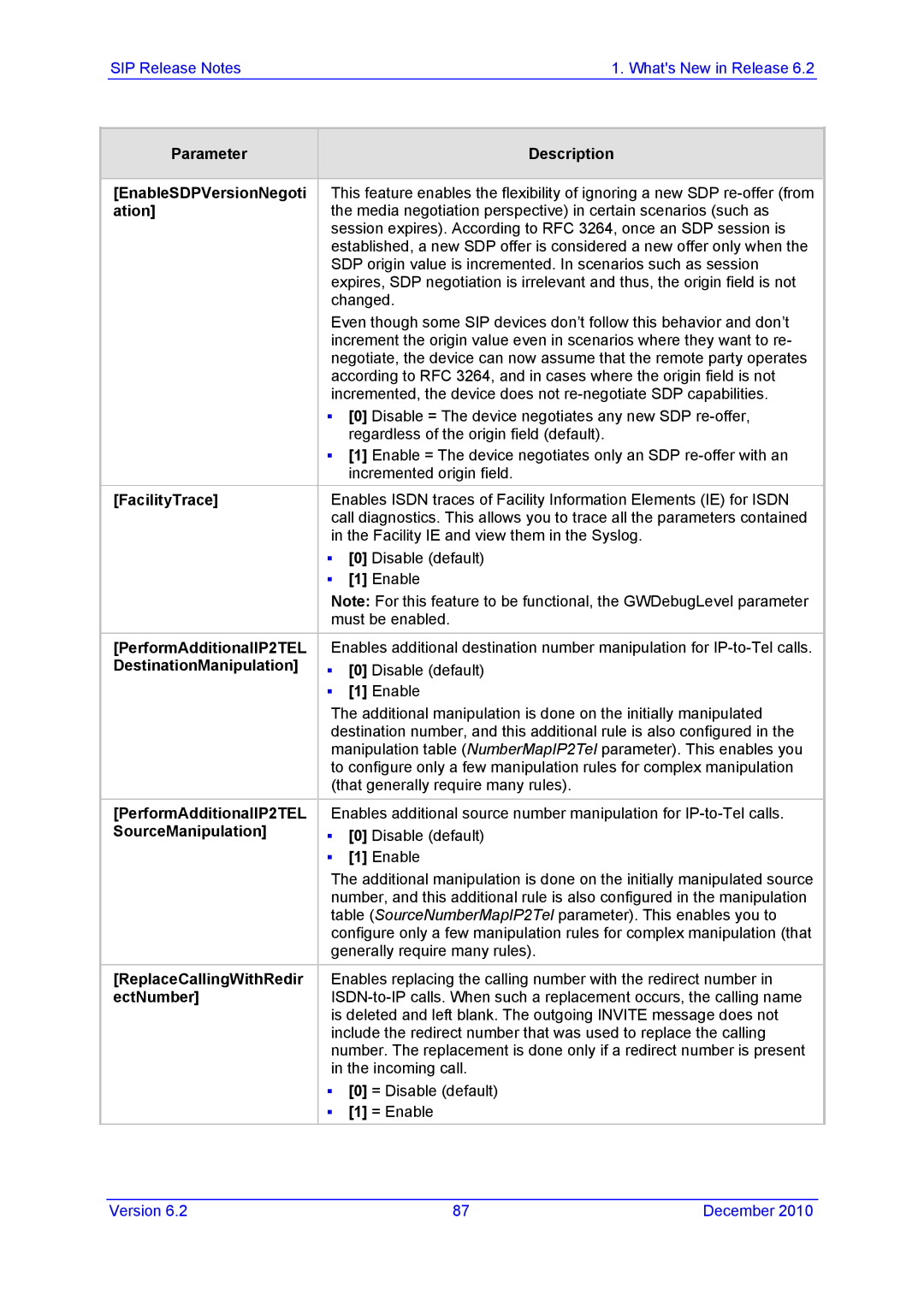| SIP Release Notes |
| 1. What's New in Release 6.2 |
|
|
|
|
|
|
| Parameter |
| Description |
|
|
|
|
|
|
| [EnableSDPVersionNegoti | This feature enables the flexibility of ignoring a new SDP |
| |
| ation] | the media negotiation perspective) in certain scenarios (such as |
| |
|
| session expires). According to RFC 3264, once an SDP session is |
| |
|
| established, a new SDP offer is considered a new offer only when the |
| |
|
| SDP origin value is incremented. In scenarios such as session |
| |
|
| expires, SDP negotiation is irrelevant and thus, the origin field is not |
| |
|
| changed. |
| |
|
| Even though some SIP devices don’t follow this behavior and don’t |
| |
|
| increment the origin value even in scenarios where they want to re- |
| |
|
| negotiate, the device can now assume that the remote party operates |
| |
|
| according to RFC 3264, and in cases where the origin field is not |
| |
|
| incremented, the device does not |
| |
|
| [0] | Disable = The device negotiates any new SDP |
|
|
| regardless of the origin field (default). |
| |
|
| [1] | Enable = The device negotiates only an SDP |
|
|
| incremented origin field. |
| |
| [FacilityTrace] | Enables ISDN traces of Facility Information Elements (IE) for ISDN |
| |
|
| call diagnostics. This allows you to trace all the parameters contained |
| |
|
| in the Facility IE and view them in the Syslog. |
| |
|
| [0] | Disable (default) |
|
|
| [1] | Enable |
|
|
| Note: For this feature to be functional, the GWDebugLevel parameter |
| |
|
| must be enabled. |
| |
| [PerformAdditionalIP2TEL | Enables additional destination number manipulation for |
| |
| DestinationManipulation] | [0] | Disable (default) |
|
|
| [1] | Enable |
|
|
| The additional manipulation is done on the initially manipulated |
| |
|
| destination number, and this additional rule is also configured in the |
| |
|
| manipulation table (NumberMapIP2Tel parameter). This enables you |
| |
|
| to configure only a few manipulation rules for complex manipulation |
| |
|
| (that generally require many rules). |
| |
| [PerformAdditionalIP2TEL | Enables additional source number manipulation for |
| |
| SourceManipulation] | [0] | Disable (default) |
|
|
| [1] | Enable |
|
|
| The additional manipulation is done on the initially manipulated source |
| |
|
| number, and this additional rule is also configured in the manipulation |
| |
|
| table (SourceNumberMapIP2Tel parameter). This enables you to |
| |
|
| configure only a few manipulation rules for complex manipulation (that |
| |
|
| generally require many rules). |
| |
| [ReplaceCallingWithRedir | Enables replacing the calling number with the redirect number in |
| |
| ectNumber] |
| ||
|
| is deleted and left blank. The outgoing INVITE message does not |
| |
|
| include the redirect number that was used to replace the calling |
| |
|
| number. The replacement is done only if a redirect number is present |
| |
|
| in the incoming call. |
| |
|
| [0] | = Disable (default) |
|
|
| [1] | = Enable |
|
Version 6.2 | 87 | December 2010 |
